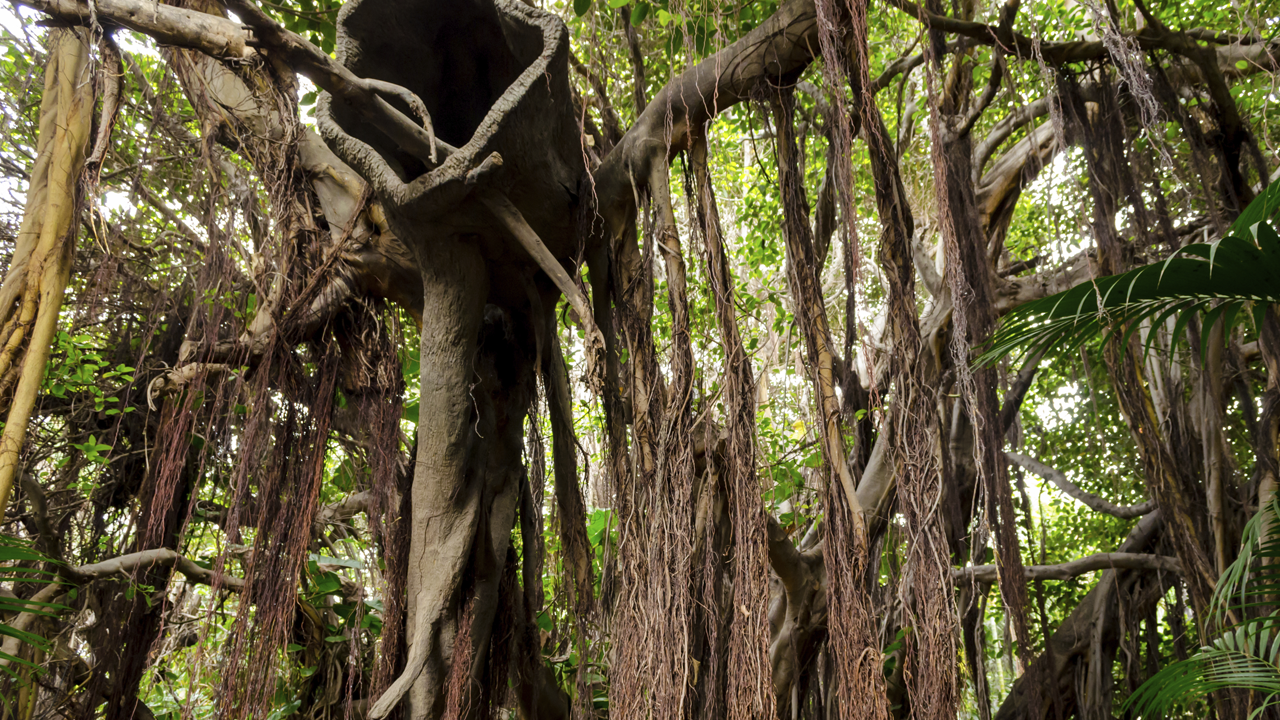
The liana vines that wind their way to the top of tropical forest canopies have the potential to significantly reduce those forests’ ability to remove and store carbon dioxide from the atmosphere, according to a study by University of Minnesota researcher Jennifer Powers and two colleagues.
Based on data from the lowland semi-deciduous forest of Panama’s Gigante Peninsula, the researchers estimate that over the next 50 years, lianas could potentially slash long-term storage of carbon in New World lowland tropical forests by 35 percent. These forests include most of the Amazon basin, as well as similar forests in Central America. Such a slowdown in this carbon “sink” would weaken the planet’s ability to dampen rises in atmospheric carbon dioxide levels.
The study is the first to show the effects of lianas on carbon storage experimentally. It appears online in the Proceedings of the National Academy of Sciences.
“Lianas are what you typically push out of your way as you walk through a tropical forest to get to the trees,” says Powers, an associate professor in the University’s Departments of Plant Biology and of Ecology, Evolution and Behavior. “The value of this study is that it clearly demonstrates that we can no longer ignore lianas when thinking about tropical forest carbon cycles.”
A Climbing Threat
Lianas comprise multiple species of vines and play multiple roles in the forest ecosystem. Rooted in the soil, they compete with trees for water and nutrients. As they wind around trees, they compress and even strangle them. In the canopy, their leaves compete with tree leaves for sunlight. Lianas also form bridges between trees; these create highways through the forest for arboreal animals and may stabilize trees against wind. Or, they may allow a falling tree to pull a neighbor down with it.
Prompted by reports that lianas can cut individual tree growth by up to 84 percent, that they boost a tree’s mortality risk by two- to three-fold, and that liana infestations are growing in New World tropical forests, Powers, along with colleagues at Marquette University and the Smithsonian Tropical Research Institute in Panama–where she also holds an appointment–and other institutions, performed a controlled study of their effects on carbon storage. For three years they measured increases in total biomass in control and liana-free plots of forest, using units of millions of grams of carbon per hectare of forest per year.
• Control plots were left undisturbed. Here, total biomass productivity comprised growth in tree stems and leaf litter for both trees and lianas.
• In liana-free plots, the researchers removed all lianas at the outset of the study and afterward as necessary. Total biomass productivity comprised only the growth in tree stems and leaf litter.
After three years, the median rate of biomass accumulation was 2.93 units for liana-free plots, but only 0.41 for controls. That implies that lianas reduced carbon storage by 86 percent. However, the researchers recalculated the statistics, taking the wide variability in the data into account, and estimated the three-year liana-induced reduction at a more conservative 76 percent. This figure shows the immense power of invading lianas to inhibit carbon storage.
To simulate future carbon storage potential, the researchers used the net biomass accumulation in each of the two groups of plots during the third year of the study as the starting point. At this point, Powers says, both liana-infested and liana-free trees seem to have reached a steady rate of carbon accumulation. And though the difference in carbon storage rates was small, over 50 years it extrapolated to the stated 35 percent reduction.
How and Why
Although lianas store carbon by growing in girth, it is negligible compared to their overall effect on biomass carbon accumulation, the researchers say.
“Lianas are woody vines, but they differ from trees in that they do not allocate a lot of resources to building a woody trunk to support the canopy of leaves,” says Powers. “They compete with trees for light above ground, where they extend their canopy of leaves above tree leaves and shade them out. They also compete effectively for resources below ground, such as soil moisture and nutrients.”
“They can also affect trees negatively through physical mechanisms. Several lianas can grow on one tree, and when lianas are removed, the tree trunks expand. It’s like seeing a person’s belly expand when they remove their belt after a Thanksgiving dinner.”
In fact, inhibiting trees from storing carbon in their trunks seems to be the chief reason for the overall decrease in total biomass carbon storage reported in the current study. Lianas shifted the partitioning of carbon storage away from woody stems toward leaves, which rapidly decompose and release their carbon back to the atmosphere.
Powers says the current project still has several steps to take in discovering the full extent of lianas’ effects. Besides extending the project beyond three years, the researchers want to learn how lianas affect root growth and dynamics and determine if their current findings apply to “the wide gamut of different types of tropical forests.”
Also, Powers says more work is needed that focuses on uncovering why liana abundances are increasing in tropical forests.
Nevertheless, lianas are native to tropical forests and contribute to their diversity and functioning. And even if desirable, large-scale removal may not be feasible.
“Removing lianas is difficult. You need a lot of machetes,” says Powers.